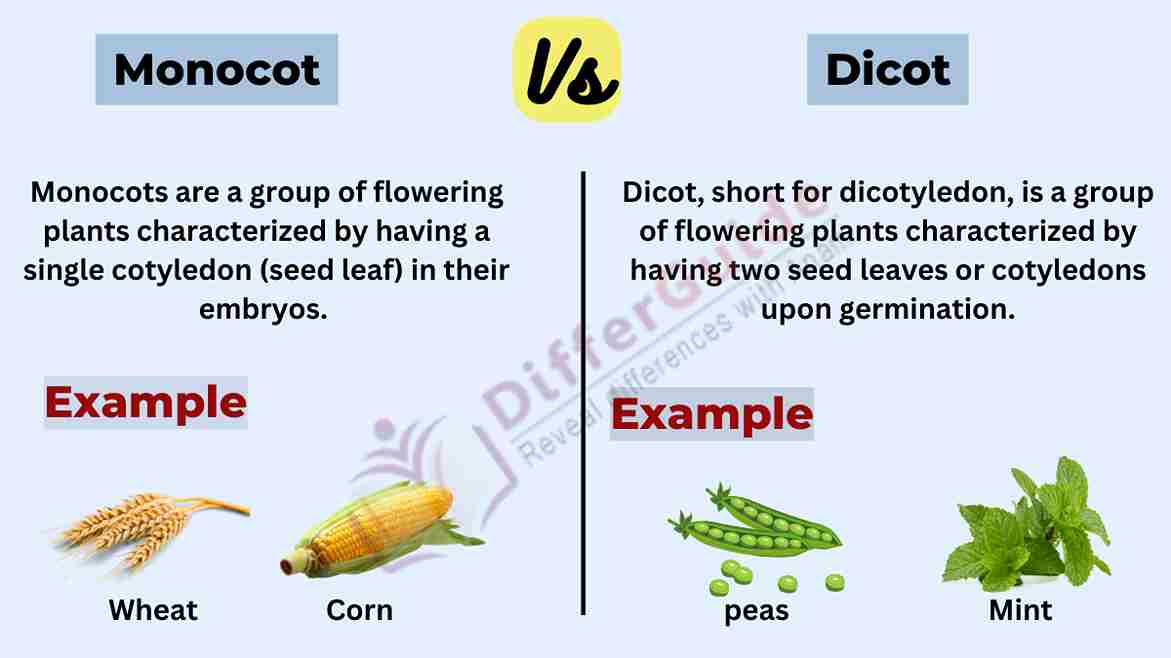The key difference between monocot and dicot is that monocots and dicots are two major groups of flowering plants (angiosperms) based on the number of cotyledons (seed leaves) in their embryos. These terms refer to embryonic structures and have implications for various aspects of plant anatomy, morphology, and growth characteristics.

What is Monocot?
The term “monocot” is derived from the Greek words “mono” meaning “single” and “kotyledon” meaning “cotyledon.” Monocots are a group of flowering plants characterized by having a single cotyledon (seed leaf) in their embryos. They are part of the larger category of angiosperms, or flowering plants. Monocots typically have parallel-veined leaves and flower parts in multiples of three (e.g., three or six petals).
Examples of monocots include grasses, lilies, orchids, and palms. The vascular bundles in their stems are scattered, not arranged in a ring. Monocots play essential roles in ecosystems as food sources, providing grains, fruits, and fibers for humans and animals.
What is Dicot?
The term “dicot” is derived from the Greek words “di” meaning “two” and “kotyledon” meaning “cotyledon.” Dicot, short for dicotyledon, is a group of flowering plants characterized by having two seed leaves or cotyledons upon germination. These plants belong to the class Magnoliopsida and are part of the larger group of angiosperms.
Dicots exhibit a wide range of forms, sizes, and habitats, with many familiar examples such as roses, sunflowers, and maple trees. Their leaves typically have a reticulate or net-like venation pattern, and their floral parts are usually in multiples of four or five. Dicots play a vital role in ecosystems, serving as a source of food, shelter, and various resources for humans and wildlife alike.
Monocot vs Dicot
Here are some key differences between monocots and dicots:
| Monocot | Dicot | |
| Cotyledon | Monocots have one cotyledon (single-seed leaf) in their embryos, | dicots have two cotyledons (double-seed leaves). |
| Leaves | Monocot leaves usually have parallel veins, | dicot leaves typically have a branched or net-like vein pattern. |
| Flower parts | Monocots typically have floral parts (such as petals, sepals, and stamens) in multiples of three (3 or multiples of 3). | Dicots, on the other hand, usually have floral parts in multiples of four or five (4 or 5, or multiples of 4 or 5). |
| Root system | Monocots usually have fibrous root systems, with a network of fine roots arising from the base of the stem. | Dicots often have a taproot system, consisting of a main root that grows vertically downward and gives rise to smaller lateral roots. |
| Stem Anatomy | Monocot stems lack a vascular cambium, which is responsible for secondary growth. | Dicot stems typically possess a vascular cambium, allowing for secondary growth and the formation of woody tissue. |
| Pollen structure | Monocots generally have pollen grains with a single furrow or pore. | Dicot pollen grains usually have three furrows or pores. |
| Example | Monocots include grasses, lilies, orchids, and palms. | Dicots encompass a wide range of plants, including roses, sunflowers, beans, and oaks. |
